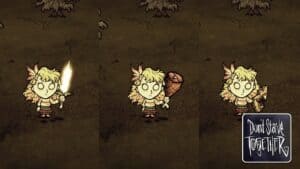There’s no doubt that farming is one of the best methods to create a sustainable food source in Don’t Starve Together.
Upon the removal of the Basic and Advanced Farm structure, which makes the farming process a lot harder, learning how to farm is essential to keep yourself alive in the Constant world.
Recommended Read: Don’t Starve Together – Nightmare Werepig Guide
This guide will cover the farming guide in Don’t Starve Together, including how to create a farm, how to farm plants (normal and giant crops), how farming works, how to water plants, and discuss what crops you should farm.
Table of Contents
How to Create a Farm
To start farming in Don’t Starve Together, you’ll need:
- Garden Digamajig: used to plow farm soil turfs.
- Garden Hoe/Splendid Garden Hoe: used to till farm soil turfs to create farm soil.
- Watering Can/Waterfowl Can: used to water farm soil turfs to increase ground moisture.
- Gardeneer Hat: used to research the crops and check the stress. This item is optional if you’re familiar with all the farming concepts.
- Shovel: used to dig Garden Detritus.
- Birdcage and Bird Trap: used to capture a bird to exchange crops for the corresponding seeds.
- Ice Boxes (Optional): used to make seeds and crops last longer.
- Beefalo Horn/Pan Flute/One-man Band (Optional): used to take care of the crops. Although you can do this by hand or with the help of the Friendly Fruit Fly, using items is advisable as it’s much quicker.
Once you have all the required tools and materials, here is how to create a farm!
First, pick your preferred farming location and use a Garden Digamajig to create one farm soil turf. Each Garden Digamajig can be used 4 times, so use it to create a 2×2 area of farm soil turf.
Next, equip a Shovel and dig all Garden Detritus in your farm soil turfs.
Then, equip a Garden Hoe and till the farm soil turf to create farm soil. For the best efficiency and aesthetic, it’s recommended to till 9 farm soils in a single farm soil turf.
If done correctly, you’ll have 4 farm soil turfs and 36 farm soils. If it’s too hard to till the soil, use this Geometric Placement mod.
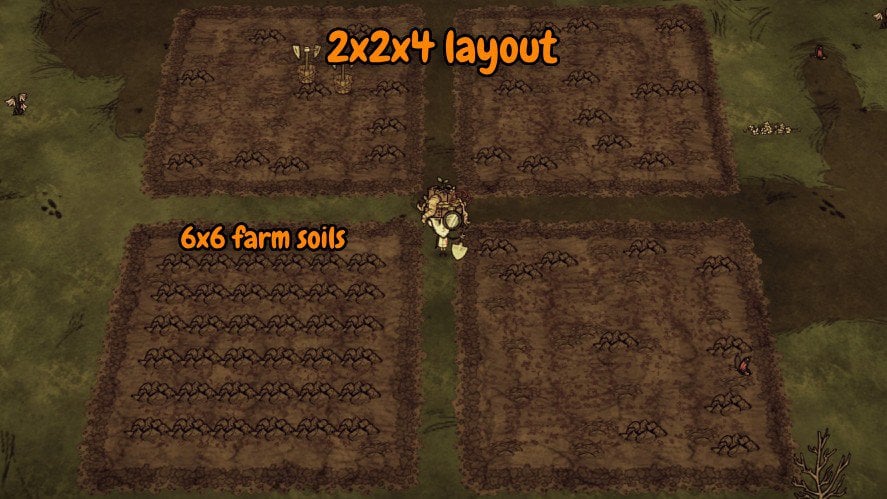
There are multiple layouts for farming in Don’t Starve Together, and the 2×2 layout above is one of the best layouts since it allows you to grow most crops with minimal space.
Depending on your preferred crops and available lands, you may want to create a 1×2 or 2x2x4 area divided by normal dirt tiles to grow your crops.
For different farming layouts, check out this post created by u/CuteLittleMine.
In the below sections, we’ll use the 2x2x4 layout for reference and only focus on a single 2×2 layout.
How to Farm Plants in DST
Once you have the farm soils, it’s time to sow seeds!
When you first start farming in DST, you don’t have specific seeds just yet. Therefore, you can’t grow your preferred crops at this moment.
So, just start with normal seeds. Run around and wait for the birds to drop some. Then, select the seeds in your inventory and left-click on farm soils to plant them.
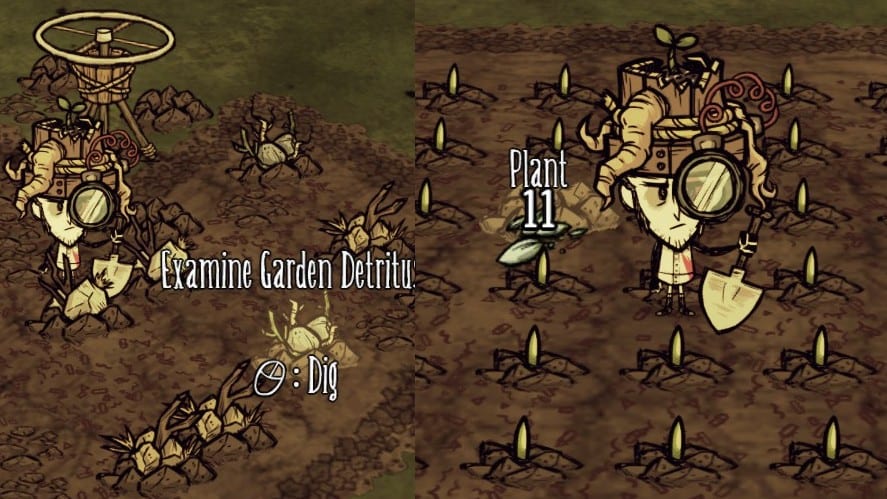
Currently, there are 14 different farm plants and 4 weeds in Don’t Starve Together.
You’ll get a random plant in the list above by planting seeds. The chance to get specific crop seeds may vary depending on the current season.
For example, a seed has a 13.2% chance to become a potato seed in Autumn but only has a 7.9% chance in Summer.
To eliminate the randomness, you must feed the bird captured in your Birdcage with your desired crops. For example, feeding potatoes to the bird will give you potato seeds in return.
As mentioned, seeds don’t just grow into normal plants but also have a 20% chance of becoming weeds.
In most cases, you must remove the weeds to reduce your plants’ stress. If you’re aiming to grow giant crops, then removing weeds is a must.
Otherwise, you can farm Forget-Me-Lots weed to make Soothing Tea. This is a great food source to restore sanity over time.
Understand Plants
Plants in DST have 5 stages:
- Seeds
- Sprout
- Small
- Medium
- Grown
Each plant has its favorite season, which affects the growth rate and chance to obtain from normal seeds when planting.
Moreover, each plant consumes a different amount of water and produces and consumes ground nutrients (Compost, Manure, and Super Growth Formula) in each stage.
The table below shows all the plants and weeds in DST, including the chance to obtain them in each season, their favorite season (marked with bold), their ground nutrients production and consumption, and the water consumption rate (per second).
| Seed | Autumn/Winter/Spring/Summer | Compost | Manure | Super Growth Formula | Water Consumption |
|---|---|---|---|---|---|
| Normal Seed | N/A | 0 | 0 | 0 | 0.02 |
| Potato | 13.2%/16.4%/12.4%/7.9% | 2 | -4 | 2 | 0.0075 |
| Carrot | 13.2%/16.4%/12.4%/7.9% | 2 | 2 | -4 | 0.0075 |
| Pepper | 2.7%/1.7%/1.3%/3.2% | 4 | -8 | 4 | 0.0075 |
| Corn | 13.2%/8.2%/12.4%/15.7% | -4 | 2 | 2 | 0.0075 |
| Garlic | 2.7%/3.3%/2.5%/3.2% | -8 | 4 | 4 | 0.0075 |
| Asparagus | 2.7%/6.6%/5%/3.2% | -4 | 2 | 2 | 0.0075 |
| Durian | 1.4%/1.7%/2.5%/1.6% | -8 | 4 | 4 | 0.0075 |
| Eggplant | 2.7%/6.6%/5%/3.2% | 2 | -4 | 2 | 0.02 |
| Dragon Fruit | 1.4%/1.7%/2.5%/3.2% | 4 | -8 | 4 | 0.02 |
| Pumpkin | 5.3%/6.6%/2.5%/3.2% | 2 | 2 | -4 | 0.02 |
| Onion | 2.7%/1.7%/2.5%/3.2% | 4 | 4 | -8 | 0.02 |
| Pomegranate | 1.4%/1.7%/2.5%/3.2% | 4 | 4 | -8 | 0.02 |
| Tomato | 13.2%/8.2%/12.4%/15.7% | -2 | 4 | -2 | 0.035 |
| Watermelon | 2.7%/3.3%/5%/6.3% | -2 | -2 | 4 | 0.035 |
| Forget-me-Lots | 15.4% in all seasons | -2 | -2 | -2 | 0.02 |
| Fire Nettles | 1.54% in all seasons | -2 | -2 | -2 | 0.02 |
| Tillweed | 1.54% in all seasons | -2 | -2 | -2 | 0.02 |
| Spiny Bindweed | 1.54% in all seasons | -2 | -2 | -2 | 0.02 |
Remember that the ground nutrient and water values are per plant and stage.
So, if you plant 9 potato seeds in a single farm soil turf, they will consume 0.0075 * 9 = 0.0675 units of water per second.
They also produce 2 * 9 * 4 = 72 (a plant has 5 stages, but you don’t need to do anything at the final stage besides harvesting) Compost and Super Growth Formula and consume 4 * 9 * 4 = 144 Manure.
Understanding the plant’s needs is essential, as failing to provide one will give your plant 1 stress point.
Before learning about stress points and their effect on your plant, let’s learn about ground attributes first!
Ground Attributes
So, where do the plants get the water and ground nutrients from? The answer is from the farm soil turf.
Each farm soil turf has 2 main attributes:
1. Ground Nutrients
Ground Nutrients contain Compost, Manure, and Super Growth Formula.
Each nutrient ranges from 0 to 100, and the starting value when creating the farm soil turf for each nutrient is between 20 and 40.
There are two main ways to increase nutrients for a farm soil turf: fertilizer items or plants.
Fertilizer items include manures, guanos, rots, rotten eggs, all stages of growth formula, spoiled fish, or even Gloomer’s goop. However, using only fertilizer items to increase nutrients is not recommended, as this method is expensive and time-consuming.
The best way to increase nutrients is to grow the corresponding plants.
For example, potatoes are best for increasing 2 Compost and 2 Super Growth Formula nutrients with the cost of 4 Manure. To refill Manure nutrients, simply pick up Manure from Beefalo or Guano from the Batilisks and use them on the farm soil turf.
2. Ground Moisture
Same as ground nutrients, each farm soil turf has a moisture meter ranging from 0 to 100.
There are multiple ways to increase ground moisture, such as:
- Use a watering can, waterfowl can, or water balloons. Each use increases 25 moisture points.
- Leave the ice on the farm soil turf. Each ice gives 20 moisture points.
- Rain increases moisture by 1.5 per second.
Remember that besides the water consumption from the plants, ground moisture can also decrease naturally if the world temperature is above 70 degrees.
Stress Mechanic
Plants in DST can gain stress points at the beginning of each stage. This point is critical, as it affects the output of your crops, as shown below.
| Total Stress Points | Crops Receive | Seeds Receive |
|---|---|---|
| 0-1 | 3 | 2 |
| 2-6 | 1 | 2 |
| 7-11 | 1 | 1 |
| 12+ | 1 | 0 |
There are 7 stress sources, meaning a plant can have up to 28 stress points when fully grown.
- Ground nutrient: as mentioned, each crop consumes and produces ground nutrients per stage. If the amount of specific nutrients in a single farm soil turf is insufficient, the plant gains 1 stress.
- Ground moisture: +1 stress point if the plant consumes less than 10% water compared to its previous stage.
- Happiness: +1 stress point if the plant isn’t taken care of.
- Season: +1 stress point if the current season isn’t the plant’s favorite.
- Killjoys: +1 stress point if rotten plants, weeds, or garden detritus are within 3 tiles.
- Family: +1 stress point if there are less than 4 plants of the same type within 2 tiles.
- Overcrowding: +1 stress point if there are 10+ plants (including weeds) in a single farm soil turf.

Besides seasons, stress points also affect the plant’s growth rate. Usually, it takes roughly 2.5 – 4 days in season and 5-8 days off-season for a plant to mature.
First Days Farming
On your first days of farming in DST, focus solely on 1-2 crops and forget about giant crops to get at least 1 crop and 1 seed back.
If you follow our guide, simply plant all 9 seeds in a farm soil turf. Remember to water the ground for each stage and take care of the plants by left-clicking on them.
As they reach the Sprout stage, you can identify if a plant is a weed by looking at its appearance and name. Then, immediately remove all weed plants to reduce some stress points for your plants.
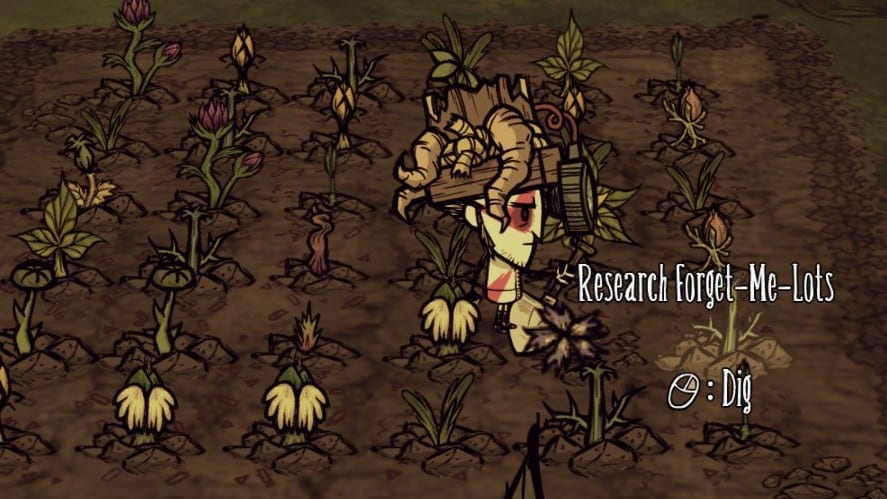
If you still can’t identify weed plants in the Sprout stage, waiting for later stages and removing them is okay.
Keep watering the ground and taking care of the plants until they’re fully grown. To harvest a plant, right-click on it.
In most cases, you’ll get 1 crop and 1 seed back. (7-11 stress points)
You get random crops for food and seeds to replant, and your farm soil turf also gains ground nutrients for later farming purposes.
Once you have various crops, feed the caged bird to get more of your preferred seeds.
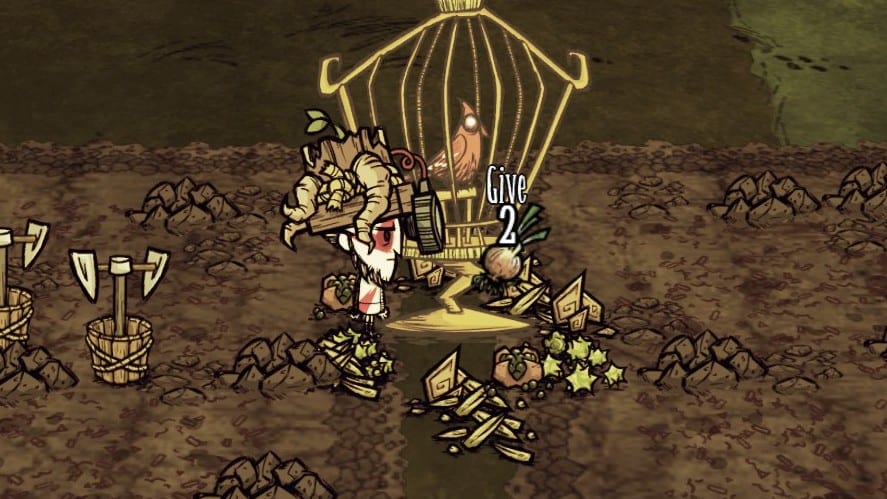
It is best to grow crops that consume Compost or Manure nutrients, as these are the two you can easily refill using rots or manures.
So, depending on the current season, consider planting potato, eggplant, pepper, dragon fruit, asparagus, corn, durian, or garlic.
It’s recommended to plant above the ground for natural light. If planted underground, you must find a place near natural light sources, like the cave entrance.
Farm plants can also be rotten after 4 (normal crops) or 6 days (giant crops), so remember to harvest them when you have the chance.
Grow Giant Crops
The overall concept of growing giant crops in DST is to minimize the stress points gained from all 7 sources.
For Ground Moisture and Plant Happiness, just keep watering the ground and taking care of the plant (or use Fruit Fly or other items).
The crops should take care of Ground Nutrients if you choose the plants correctly.
For example, a farm soil turf with 1 potato and 1 tomato won’t provide any stress points from the ground nutrients source to the plants at all, as the potato produces 2 Compost, 2 Super Growth Formula, and consumes 4 Manure.
In contrast, the tomato produces 4 Manure and consumes 2 Compost and 2 Super Growth Formula.

If you remove all Garden Detritus, rotten plants, and weeds and only plant 9 crops in a single farm soil turf, then you’re good with Killjoys and Overcrowding stress sources.
The last two stress sources involve the season and the farming space (4 plants of the same type within 2 tiles). However, if you follow the layout we suggested (2×2), you’re also good with the Family stress source.
Your plant will automatically get 4 stress points if planted off-season. So, getting giant crops off-season is impossible.
Alternatively, you can get giant crops by planting only 1 seed type. In this case, you must pay close attention to the Ground Nutrients by pre-planting other seeds first to get the required nutrients.
For instance, you can plant 8 tomatoes to get the required manure for dragon fruits first. Then, harvest them and plant 4 dragon fruits in the Spring or Summer to satisfy the Ground Nutrients and Season stress sources.
How to Water Plants
You can’t water plants in DST, but rather water the farm soil turf on which the crops are planted.
First, you must craft a Watering Can with 2 Boards and 1 Rope.
Next, equip the Watering Can in your hand slot, find a pond (not ocean), and right-click on it to gather water. You can also select the Watering Can in your inventory and left-click on a pond for the same action.
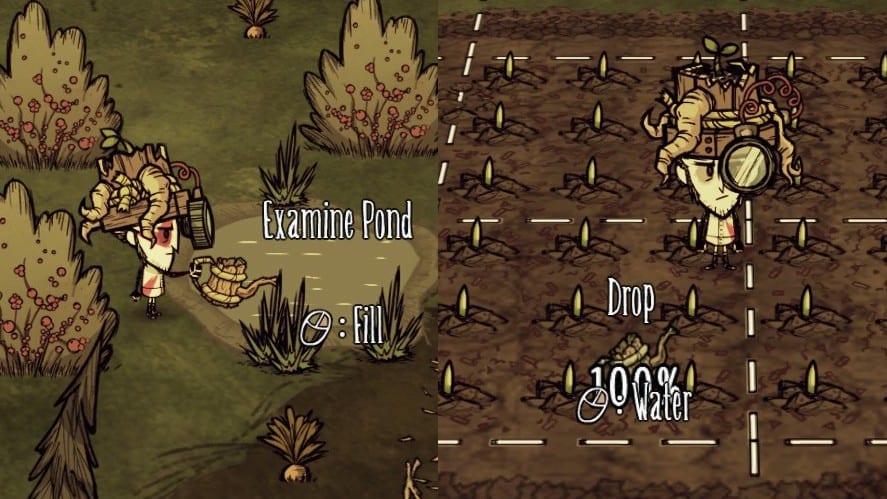
To water the farm soil turf, equip the Watering Can and right-click on it. Alternatively, you can select the Watering Can and right-click on the turf.
Other ways to effectively water plants are to do the farm when it’s raining or read the Practical Rain Rituals book to summon rain if your team has Wickerbottom.
What Crops Should You Farm
The crops you should farm in Don’t Starve Together depend greatly on your needs, the current season, the available seeds, and the available space you can afford.
However, here are the crops that have significant usage and minimal requirements:
- Potato: can be cooked to obtain Roasted Potato, which restores 20 health and 25 hunger.
- Tomato: used to cook Vegetable Stinger, an excellent food source that restores 25 hunger and 33 sanity.
- Dragon Fruit: used to cook Dragonpie, which restores 40 heath and 75 hunger.
- Carrot: used to build Rabbit Hutch to farm other materials.
For Autumn, Winter, and Spring, use the [1 potato:1 carrot:1 corn] ratio to get giant crops. With a 2×2 layout, you can farm up to 12 potatoes, 12 carrots, and 12 corn.
In the Spring or Summer, use the [2 tomato:1 dragon fruit] ratio. To get giant tomatoes and dragon fruits, use two farm soil turfs and plant 12 tomatoes on the outside and 6 dragon fruits inside so they can satisfy the Family stress source.
That’s all you need to know about farming in Don’t Starve Together!
Have any suggestions for this guide? Let us know in the comments section below.


